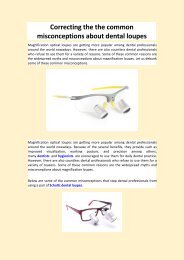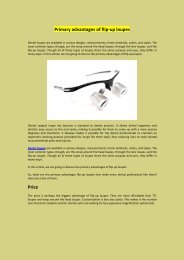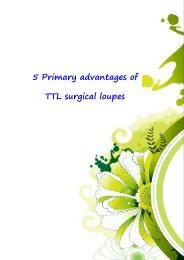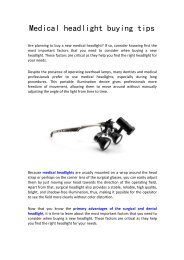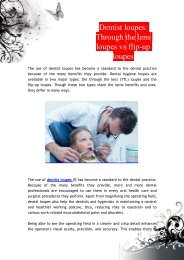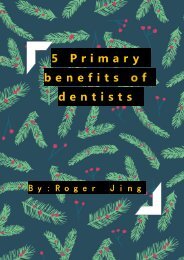6 Important factors to check out when purchasing dental loupes
Dental loupes play a critical part in the success of any dental procedure that you will perform. Schultz offer benefits of the dental loupes which you need to consider when purchasing a new loupe.
Dental loupes play a critical part in the success of any dental procedure that you will perform. Schultz offer benefits of the dental loupes which you need to consider when purchasing a new loupe.
You also want an ePaper? Increase the reach of your titles
YUMPU automatically turns print PDFs into web optimized ePapers that Google loves.
6 <strong>Important</strong> <strong>fac<strong>to</strong>rs</strong> <strong>to</strong> <strong>check</strong> <strong>out</strong> <strong>when</strong><br />
<strong>purchasing</strong> <strong>dental</strong> <strong>loupes</strong><br />
Dental <strong>loupes</strong> play a critical part in the success of any <strong>dental</strong> procedure that you will<br />
perform. They have been proven <strong>to</strong> offer a wide range of benefits both <strong>to</strong> the dentists<br />
and the patients. However, you can only reap the many benefits the <strong>dental</strong> <strong>loupes</strong> offer<br />
if you are able <strong>to</strong> find the one that best fits you. Here are a few important <strong>fac<strong>to</strong>rs</strong> that<br />
you need <strong>to</strong> consider <strong>when</strong> <strong>purchasing</strong> a new loupe.<br />
Using the right <strong>dental</strong> <strong>loupes</strong> is critical <strong>to</strong> the success of any <strong>dental</strong> procedure that you<br />
will perform. They help improve clinical results by allowing you <strong>to</strong> have better<br />
visualization of the oral cavity. With a better visual acuity, your precision <strong>when</strong> it<br />
comes <strong>to</strong> judgment or diagnosis, treatment, and overall performance is likewise being<br />
enhanced.<br />
However, you can only reap the many benefits the <strong>dental</strong> <strong>loupes</strong> offer if you are able<br />
<strong>to</strong> find the one that best fits you. But how can you be able <strong>to</strong> find the right pair for you?<br />
Here are a few important <strong>fac<strong>to</strong>rs</strong> that you need <strong>to</strong> consider <strong>when</strong> <strong>purchasing</strong> a new<br />
loupe.<br />
Magnification Power
Proper magnification is becoming a standard in dentistry. Dental magnification can<br />
range from 2.0x <strong>to</strong> 6.0x. To know which magnification power <strong>to</strong> choose, you need <strong>to</strong><br />
determine first how you are going <strong>to</strong> use the <strong>dental</strong> hygiene <strong>loupes</strong>.<br />
Each of the <strong>dental</strong> procedures has specific magnification requirement. For instance,<br />
general <strong>dental</strong> care procedures require minimal magnification only. Whilst, intricate<br />
procedures that require more focus will need higher magnification power.<br />
Working Distance<br />
Working distance is the distance between you and the operating field. The right<br />
working distance will allow you <strong>to</strong> work in an upright, healthy, and neutral posture<br />
while still having a good visual acuity. It likewise promotes healthy posture and helps<br />
reduce your risk <strong>to</strong> work-related musculoskeletal disorders and injuries.<br />
Working distance can vary from one person <strong>to</strong> another. It is important that you know<br />
your working distance <strong>when</strong> buying a new <strong>dental</strong> loupe. To get your working distance,<br />
sit down or stand up in a comfortable and upright position, with your head tilt<br />
downwards at around 25 degrees, and then measure the distance between the upper<br />
bridge of your nose and the m<strong>out</strong>h of your patient.<br />
Prescription Glasses<br />
Dental <strong>loupes</strong> for sale do not come with an accurate prescription. If you are wearing<br />
prescription glasses, make sure <strong>to</strong> let the loupe manufacturer ab<strong>out</strong> it. You can choose<br />
<strong>to</strong> use contact lenses or have your prescription added <strong>to</strong> your new <strong>loupes</strong>.
Declination Angle<br />
The declination angle has something <strong>to</strong> do with how much you need <strong>to</strong> tilt your head<br />
downward. The steeper the declination angle is, the better. This means that you only<br />
have <strong>to</strong> tilt your head a little bit <strong>to</strong> see the operating field. The ideal angle of<br />
declination is 25 degrees.<br />
Weight<br />
Weight has been a major deciding fac<strong>to</strong>r <strong>when</strong> it comes <strong>to</strong> choosing the best <strong>dental</strong><br />
<strong>loupes</strong>. Weight can build up over time most especially if you use the <strong>loupes</strong> for<br />
extended periods of time. When the weight starts <strong>to</strong> build up, it can affect your focus<br />
and comfort, thus affecting the quality of your performance as well. It can as well<br />
cause neck and shoulder pain. As much as possible, opt for the loupe that has the<br />
lightest weight.
Interpupillary Distance<br />
The interpupillary distance or PD is quite subjective. It is the distance between centers<br />
of the pupils of your two eyes. It is measured in millimeters (mm). PD is critical for<br />
correct positioning of the TTL <strong>loupes</strong>. You can seek help from an optician <strong>to</strong> know the<br />
exact measurement of your PD.<br />
Aside from the above-mentioned <strong>fac<strong>to</strong>rs</strong>, you also need <strong>to</strong> consider the loupe's field of<br />
view, depth of field, frame, design, resolution, and quality of optics. You also need <strong>to</strong><br />
decide whether you will pick through the lens <strong>loupes</strong> or flip-up <strong>loupes</strong>.





